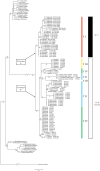Plant evolution in alkaline magnesium-rich soils: A phylogenetic study of the Mediterranean genus Hormathophylla (Cruciferae: Alysseae) based on nuclear and plastid sequences
- PMID: 30576314
- PMCID: PMC6303028
- DOI: 10.1371/journal.pone.0208307
Plant evolution in alkaline magnesium-rich soils: A phylogenetic study of the Mediterranean genus Hormathophylla (Cruciferae: Alysseae) based on nuclear and plastid sequences
Abstract
Habitats with alkaline edaphic substrates are often associated with plant speciation and diversification. The tribe Alysseae, in the family Brassicaceae, epitomizes this evolutionary trend. In this lineage, some genera, like Hormathophylla, can serve as a good case for testing the evolutionary framework. This genus is centered in the western Mediterranean. It grows on different substrates, but mostly on alkaline soils. It has been suggested that diversification in many lineages of the tribe Alysseae and in the genus Hormathophylla is linked to a tolerance for high levels of Mg+2 in xeric environments. In this study, we investigated the controversial phylogenetic placement of Hormathophylla in the tribe, the generic limits and the evolutionary relationships between the species using ribosomal and plastid DNA sequences. We also examined the putative association between the evolution of different ploidy levels, trichome morphology and the type of substrates. Our analyses demonstrated the monophyly of the genus Hormathophylla including all previously described species. Nuclear sequences revealed two lineages that differ in basic chromosome numbers (x = 7 and x = 8 or derived 11, 15) and in their trichome morphology. Contrasting results with plastid genes indicates more complex relationships between these two lineages involving recent hybridization processes. We also found an association between chloroplast haplotypes and substrate, especially in populations growing on dolomites. Finally, our dated phylogeny demonstrates that the origin of the genus took place in the mid-Miocene, during the establishment of temporal land bridges between the Tethys and Paratethys seas, with a later diversification during the upper Pliocene.
Conflict of interest statement
The authors have declared that no competing interests exist.
Figures






Similar articles
-
Phylogenetic relationships in Brassicaceae tribe Alysseae inferred from nuclear ribosomal and chloroplast DNA sequence data.Mol Phylogenet Evol. 2013 Dec;69(3):772-86. doi: 10.1016/j.ympev.2013.06.026. Epub 2013 Jul 10. Mol Phylogenet Evol. 2013. PMID: 23850498
-
A world-wide perspective on crucifer speciation and evolution: phylogenetics, biogeography and trait evolution in tribe Arabideae.Ann Bot. 2013 Oct;112(6):983-1001. doi: 10.1093/aob/mct165. Epub 2013 Jul 31. Ann Bot. 2013. PMID: 23904444 Free PMC article.
-
Hybridization and long-distance colonization at different time scales: towards resolution of long-term controversies in the sweet vernal grasses (Anthoxanthum).Ann Bot. 2013 Oct;112(6):1015-30. doi: 10.1093/aob/mct170. Epub 2013 Aug 1. Ann Bot. 2013. PMID: 23912698 Free PMC article.
-
Unraveling patterns and processes of diversification in the South Andean-Patagonian Nassauvia subgenus Strongyloma (Asteraceae, Nassauvieae).Mol Phylogenet Evol. 2019 Jul;136:164-182. doi: 10.1016/j.ympev.2019.03.004. Epub 2019 Mar 8. Mol Phylogenet Evol. 2019. PMID: 30858079
-
Molecular phylogenetic analyses of nuclear and plastid DNA sequences support dysploid and polyploid chromosome number changes and reticulate evolution in the diversification of Melampodium (Millerieae, Asteraceae).Mol Phylogenet Evol. 2009 Oct;53(1):220-33. doi: 10.1016/j.ympev.2009.02.021. Epub 2009 Mar 9. Mol Phylogenet Evol. 2009. PMID: 19272456 Free PMC article.
Cited by
-
Multiple Drivers of High Species Diversity and Endemism Among Alyssum Annuals in the Mediterranean: The Evolutionary Significance of the Aegean Hotspot.Front Plant Sci. 2021 Apr 27;12:627909. doi: 10.3389/fpls.2021.627909. eCollection 2021. Front Plant Sci. 2021. PMID: 33986760 Free PMC article.
-
Trichome Biomineralization and Soil Chemistry in Brassicaceae from Mediterranean Ultramafic and Calcareous Soils.Plants (Basel). 2021 Feb 17;10(2):377. doi: 10.3390/plants10020377. Plants (Basel). 2021. PMID: 33671132 Free PMC article.
References
-
- Al-Shehbaz IA. A generic and tribal synopsis of the Brassicaceae (Cruciferae). Taxon. 2012;61:931–954.
-
- Al-Shehbaz IA, Beilstein MA, Kellogg EA. Systematics and phylogeny of the Brassicaceae (Cruciferae): An overview. Plant Syst Evol. 2006;259:89–120. 10.1007/s00606-006-0415-z - DOI
-
- Warwick SI, Sauder CA, Al-Shehbaz IA. Phylogenetic relationships in the tribe Alysseae (Brassicaceae) based on nuclear ribosomal ITS DNA sequences. Botany. 2008;86:315–336. 10.1139/B08-013 - DOI
-
- Avetisian VE. The system of the family Brassicaceae (in Russia). Bot Zhurn. 1983;68:1297–1305.
-
- Hayek A. Entwurf eines Cruciferen-systems auf phylogenetischer Grundlage. Beih Bot Centralbl. 1911;27:127–335.
Publication types
MeSH terms
Substances
LinkOut - more resources
Full Text Sources

